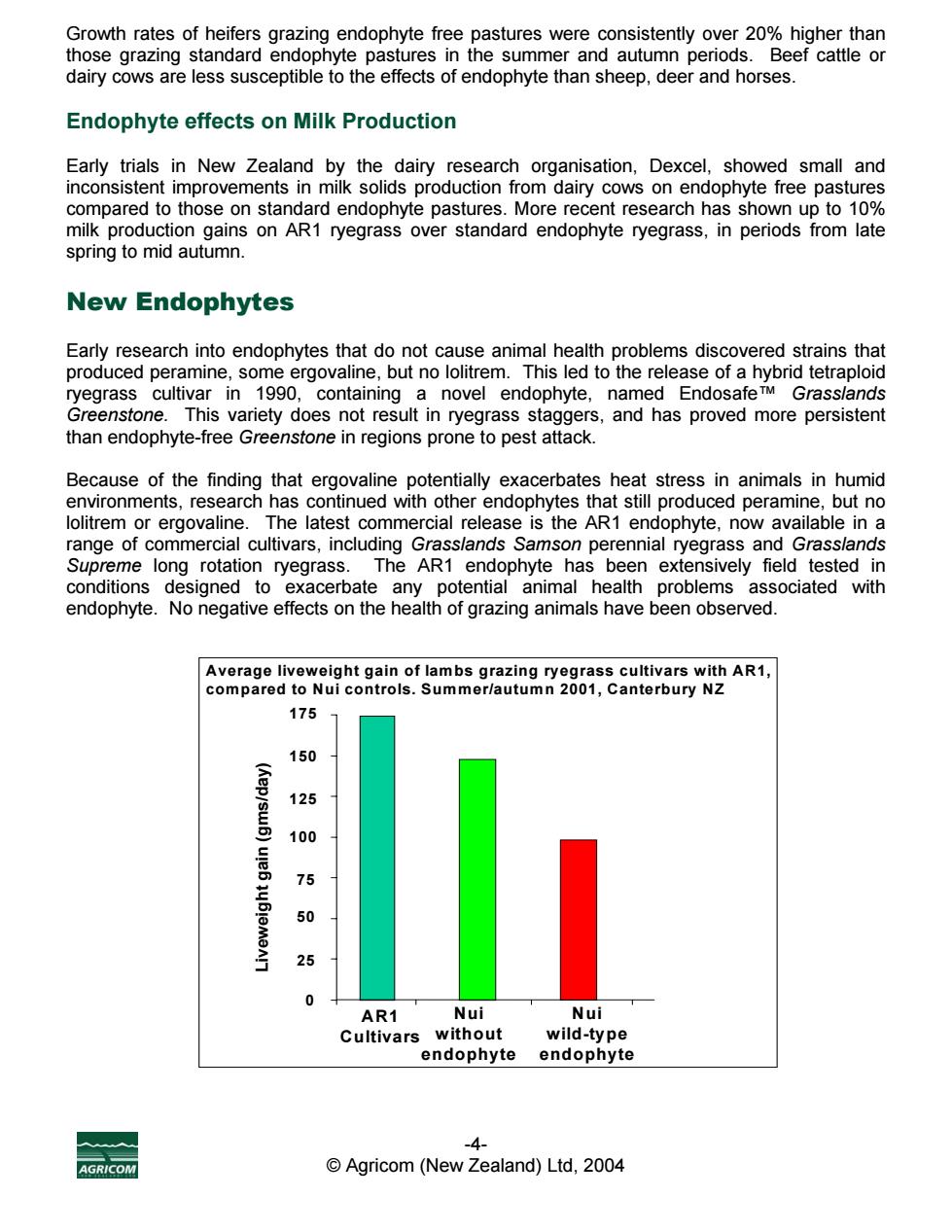正在加载图片...

Growth rates of heifers those s gra do Beef cattle or Endophyte effects on Milk Production Early trials in New Zealand by the dairy research organisation,Dexcel,showed small and inconsistent improvements in milk solids production from dairy cows on endophyte free pastures compared to those on standard endophyte pastures.More recent research has shown up to 10% milk production gains on AR1 ryegrass over standard endophyte ryegrass,in periods from late spring to mid autumn. New Endophytes Early research into endophytes that do not cause animal health problems dis overed strains tha produced peramine,some ergovaline,but no lolitrem. Ihis le ryegrass cultivar in 1990 a novel endophyte, Grasslands Greenstone. This variety does not result in ryegrass staggers,and has proved more persistent than endophyte-free Greenstone in regions prone to pest attack. Because of the finding that ergovaline potentially exacerbates heat stress in animals in humid environments,research has continued with other endophytes that still produced peramine,but no lolitrem or ergovaline.The latest commercial release is the AR1 endophyte,now available in a range of commercial cultivars,including Grasslands Samson perennial ryegrass and Grasslands Supreme long rotation ryegrass.The AR1 endophyte has been extensively field tested in conditions designed to any potential animal health problems associated with endophyte.No negative effects on the health of grazing animals have been observed. 175 150 12s 100 75 0 AR1 Nui Nui Cultivars without wild-type endophyte endophyte y Agricom(New Zealand)Ltd,2004Growth rates of heifers grazing endophyte free pastures were consistently over 20% higher than those grazing standard endophyte pastures in the summer and autumn periods. Beef cattle or dairy cows are less susceptible to the effects of endophyte than sheep, deer and horses. Endophyte effects on Milk Production Early trials in New Zealand by the dairy research organisation, Dexcel, showed small and inconsistent improvements in milk solids production from dairy cows on endophyte free pastures compared to those on standard endophyte pastures. More recent research has shown up to 10% milk production gains on AR1 ryegrass over standard endophyte ryegrass, in periods from late spring to mid autumn. New Endophytes Early research into endophytes that do not cause animal health problems discovered strains that produced peramine, some ergovaline, but no lolitrem. This led to the release of a hybrid tetraploid ryegrass cultivar in 1990, containing a novel endophyte, named Endosafe™ Grasslands Greenstone. This variety does not result in ryegrass staggers, and has proved more persistent than endophyte-free Greenstone in regions prone to pest attack. Because of the finding that ergovaline potentially exacerbates heat stress in animals in humid environments, research has continued with other endophytes that still produced peramine, but no lolitrem or ergovaline. The latest commercial release is the AR1 endophyte, now available in a range of commercial cultivars, including Grasslands Samson perennial ryegrass and Grasslands Supreme long rotation ryegrass. The AR1 endophyte has been extensively field tested in conditions designed to exacerbate any potential animal health problems associated with endophyte. No negative effects on the health of grazing animals have been observed. 0 100 150 Nui without endophyte Nui wild-type endophyte Liveweight g ain (gms/da y) 175 125 75 50 25 Average liveweight gain of lambs grazing ryegrass cultivars with AR1, compared to Nui controls. Summer/autumn 2001, Canterbury NZ AR1 Cultivars -4- © Agricom (New Zealand) Ltd, 2004